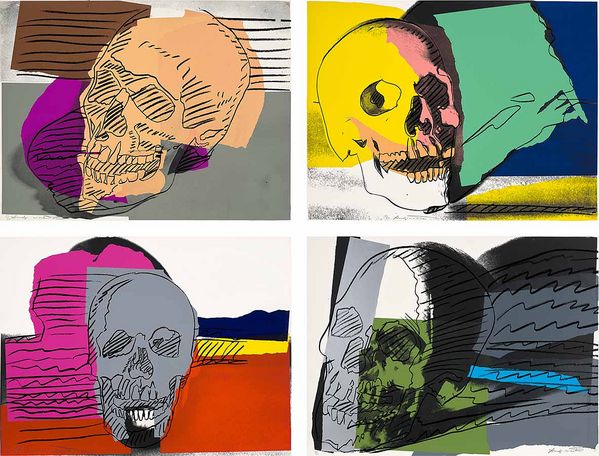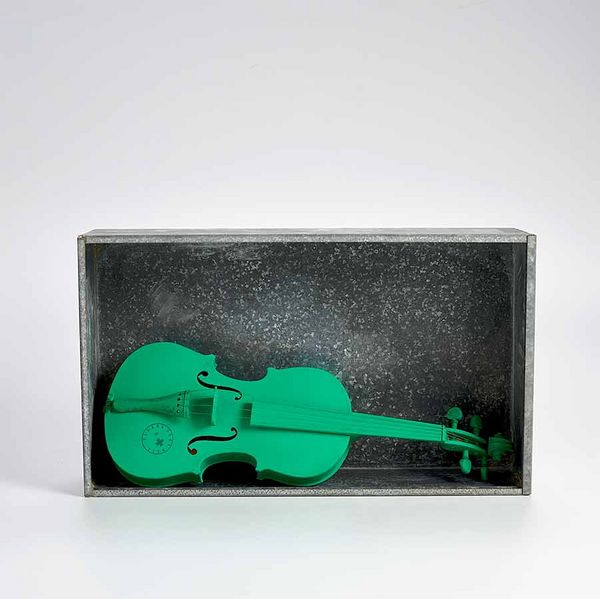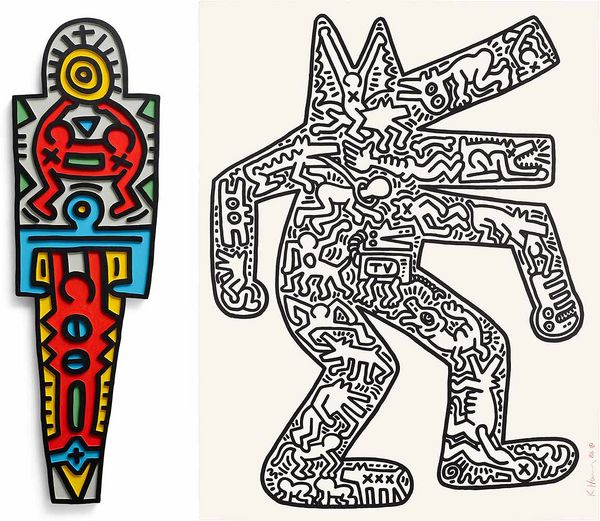Andy Warhol, Skulls, 1976. Evening & Day Editions, London.
The question of eternity can be answered much more artfully than we might be accustomed to. So to kick off the new year and explore its themes of rebirth and renewal, we turn to several artists in our 17-18 January Evening & Day Editions Sale for some of their viewpoints on the ways in which creation has no expiration.
Andy Warhol: Having the time of your afterlife
The idea is not to live forever, but to create something that will.
– Andy Warhol
June 3rd, 1968, New York. Having been shot through the torso twice, a man considered to be a mere vagrant is pronounced dead at the hospital. Five and a half hours later, after a grueling surgery, Andy Warhol returns to life on Dr. Giuseppe Rossi's operating table, and his art in this subsequent period would go on to be epitomized by the way the artist came to define himself: a sudden, undeniable mortal. The Warhol of this era was as preoccupied with death and destruction as any pathology would allow; however, to think of this turn as an all-encompassing consequence of the event is to neglect the more life-affirming side of things, and nowhere is this more apparent than in the Skulls series. These prints from 1976 encompass the artist’s characteristic use of bold color and macabre subjects in striking juxtaposition, laying bare the reality of our physical form with the ornamental flourish that so rebelliously defies it. In the era of Studio 54 and packed dance halls, Warhol’s catacomb is bathed in the disco lights of the world above it. The living world’s complications and contradictions bring about art that stands above and beyond them, as Warhol’s quote implies, and the thought surely crossed his mind during his lengthy recuperation – that the good doctor didn’t recognize one of the most famous artists of the 20th century is more than reasonable; after all, what’s a face but a dolled up skull?
Nam June Paik: Welcome to the machine
Nam June Paik, Born Again, 1991 (left), and Before the Word there was Light, after the Word there will be Light, 1992 (right). Evening & Day Editions, London.
Skin has become inadequate in interfacing with reality. Technology has become the body's new membrane of existence.
– Nam June Paik
Before the internet, there was television. Before television, dinosaurs roamed the Earth. Television is not real life. It’s been drilled into our heads to nauseating degrees – hopefully, at least. If we take the advice at face value, it’s correct. Life starts in the world and ends up in a box. Television, in contrast, starts in a box and ends up in the world. If we take the perspective of Nam June Paik, things get much more interesting. Today’s permanent interconnectedness was once analog, as the artefactual Born Again and Before the Word there was Light, after the Word there will be Light attest to, and their almost eerie obsolescence is rendered fresh with Paik’s wry foresight. These technological totems find new life through their recontextualization: once symbols of the shrinking world, they become part of the vast expanse we know today as the internet of things. Digital capture is fast and permanent: the speed from candle to cathode to circuit can feel, in relative terms, like time around us has stopped entirely, and yet we become further entrenched in the network to the point of total, eternal abstraction. Before data there was humanity, and after humanity there will be data.
Joseph Beuys: The devil went down to Mönchengladbach
Joseph Beuys, Zwei Fluxus-Objekte: Grüne Geige (Two Fluxus Objects: Green Violin), 1974. Evening & Day Editions, London.
Art alone makes life possible – this is how radically I should like to formulate it. I would say that without art man is inconceivable in physiological terms.
– Joseph Beuys
History abounds with Faustian bargains, and no instrument embodies the soul of the artist quite like the violin. Paganini embraced the rumors of his deal with the devil in exchange for virtuosity; Saint-Saëns’ Danse Macabre is based on the old superstition of death summoning the dead from their graves with his violin. The prevailing rejoinder is that death ultimately outplays us, but in the context of music, does it really? The song doesn’t end when the fiddler stops playing; it only ends when there are no fiddlers left to play it, and with an eternal audience waiting to be awakened, the musician might not be getting the short end of the deal, after all. Joseph Beuys’ Zwei Fluxus-Objekte: Grüne Geige encapsulates the artist’s experimental aktionen (“action”) entitled …Or should we change it with composer Henning Christiansen, who played a green-painted violin replicated in the present work. Beuys' aktionen were heavily symbolic performance-based events that sought to provoke social and political conversation. The violin is defiant in its coffin-like encasement, turning the question of the bargain on its head: if making music is to make immortal the creative act of a shared soul, so much so that it can even bring the dead back to life, then really, what does the devil get but one’s ego? It seems like a decent deal, all considered.
Keith Haring: Resurrection is the best redemption
Keith Haring, Totem (Wood), 1988 (left), and Dog, 1986-87. Evening & Day Editions, London.
My drawings don’t try to imitate life; they try to create life, to invent life.
– Keith Haring
Our theme culminates with Keith Haring’s reflections on life and death in the forms of Totem (Wood) and Dog. Both iconic works within Haring’s oeuvre, they come from a pivotal period in the artist’s life: between 1986 and 1989, Haring lost Andy Warhol, close friend Bobby Breslau, ex-lover Juan Dubose and best friend Yves Arman, along the countless others who were battling the then-death sentence of AIDS, which Haring himself would be diagnosed with in 1988. His works from these years take on a contemplative visual language; one which makes use of symbols, spirituality, and historical conversations in meaning-making to remarkable effect. Just as the burial chamber displays the story of the pharaoh’s mortal life, so too does it make preparations for the possibility of his trip to a greater beyond, and Haring embalms this lexicon as a visual whole, creating a new language entirely – in the image of death, Haring invents life; in his losses and meditations, he lays the groundwork for his pyramid. Anubis stands sentinel at his side, overlooking the two conjoined figures on the chest of Totem; between them a strip of green over the heart – green, of course, the color of Osiris’ skin; the color of rebirth. From the stillness emerges a reunion.
Discover More from Evening & Day Editions >
Recommended Reading
Cozy Season with Winter Editions >
In Conversation: Pauline Schellmann & Anne Schneider-Wilson >



